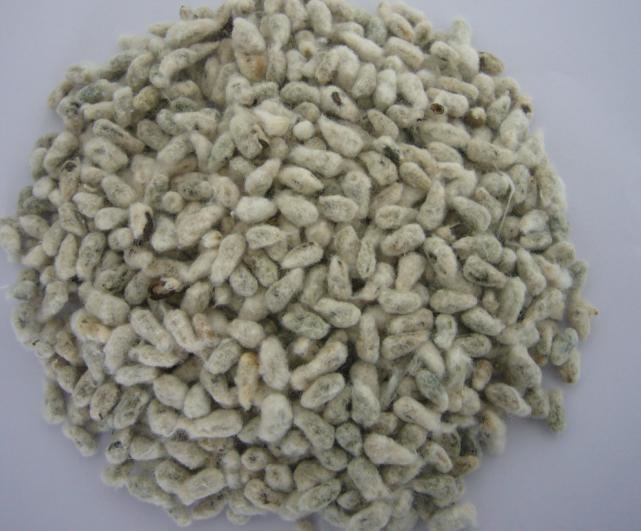 | ||
Similar Cottonseed meal, Soybean meal, Seed oil, Animal feed, Rapeseed | ||
Drive by truckers cottonseed
Cottonseed is the seed of the cotton plant.
Contents
The mature seeds are brown ovoids weighing about a tenth of a gram. By weight, they are 60% cotyledon, 32% coat and 8% embryonic root and shoot. These are 20% protein, 20% oil and 3.5% starch. Fibers grow from the seed coat to form a boll of cotton lint. The boll is a protective fruit and when the plant is grown commercially, it is stripped from the seed by ginning and the lint is then processed into cotton fibre. For unit weight of fibre, about 1.6 units of seeds are produced. The seeds are about 15% of the value of the crop and are pressed to make oil and used as ruminant animal feed. About 5% of the seeds are used for sowing the next crop. The proper method to test moisture in seed is by taking sample of 100 gram & put it simply in Meters & than read the meter

Feed products for livestock
With the advancement of technology, the processing of food has become considerably convenient. As a result, cottonseed has been able to flourish in new markets such as feed products for livestock. Cottonseed is crushed in the mill after removing lint from the cotton boll. The seed is further crushed to remove any remaining linters or strands of minute cotton fibres. The seeds are further hulled and polished to release the soft and high-protein meat. These hulls of the cottonseed are then mixed with other types of grains to make it suitable for the livestock feed. Cottonseed meal and hulls are the most abundantly available natural sources of protein and fibre used to feed livestock.
Cottonseed meal

Cottonseed meal is a good source of protein. The two types of meal extraction processes are solvent extraction and mechanical extraction. Most of the meal is extracted mechanically through cottonseed kernels. The flaked cottonseed kernels are put into high pressure through a screw inside a barrel which is constantly revolving. The screw pushes out the oil through the openings made in the barrel. The dry pieces left in the barrel are preserved and ground into meal. During the solvent extraction process, the cottonseed kernels are subjected to fine grinding by pushing them through an expander and then the solvent is used to extract most of the oil. The solvent-extracted meals have a lower fat content of 0.5% than the mechanically extracted meals with a fat content of 2.0%. Cottonseed meal is considered to have more arginine than soybean meal. Cottonseed meal can be used in multiple ways: either alone or by mixing it with other plant and animal protein sources.
Cottonseed hulls

The outer coverings of the cottonseed, known as cottonseed hulls, are removed from the cotton kernels before the oil is extracted. Cottonseed hulls serve as an excellent source of feed for the livestock as they contain about 8% of cotton linters which have nearly 100% cellulose in them. They require no grinding and easily mix with other feed sources. As they are easy to handle, their transportation cost is fairly low, as well. Whole cottonseed is another feed product of cottonseed used to feed livestock. It is the seed left after the separation of long fibres from cotton, and serves as a good source of cellulose for ruminants. Whole cottonseed leads to high production of milk and fat, if it is being fed to a high-producing dairy cow. It can be cost effective and provides nutrients such as high protein value of about 23%, crude fibre value of 25%, and high energy value of 20%. Whole cottonseed serves as a highly digestible feed which also improves the reproductive performance in livestock. Pima cottonseed, which is free of linters by default, and delinted cottonseed are other types of cottonseed feed products.
Cottonseed oil
The seed oil extracted from the kernels, after being refined, serves as a good edible and nutritious food. It can be used as a cooking oil, salad dressings. It is also used in the production of shortening and margarine. Cotton grown for the extraction of cottonseed oil is one of major crops grown around the world for the production of oil, after soy, corn, and canola.
Fertilizer
The cottonseed meal after being dried can be used as a dry organic fertilizer, as it contains 41% protein and contains other natural nutrients such as omega-9 fatty acids. It can also be mixed with other natural fertilizers to improve its quality and use. Due to its natural nutrients, cottonseed meal improves soil's texture and helps retain moisture. It serves as a good source of natural fertilizers in dry areas due to its tendency of keeping the soil moist. Cottonseed meal and cottonseed ashes are also sometimes used to supplement organic hydroponic solutions. Cottonseed meal fertilizers can be used for roses, camellias, or vegetable gardens.
Cosmetics
The fine quality oil extracted from cottonseed during the extraction process is also used in cosmetics, such as moisturizing lotions and bath soaps.
